Sexual reproduction in plants
1/77
There's no tags or description
Looks like no tags are added yet.
Name | Mastery | Learn | Test | Matching | Spaced |
|---|
No study sessions yet.
78 Terms
In angiosperms, how is the female ovule arranged?
It is never exposed but is enclosed within a modified leaf called a carpel.
What is the key feature of the success of flowering plants?
It is their relationship with animals.
What are the basic structures of parts of a flower?
• Petals
• Stigma
• Style
• Carpel
• Ovary
• Ovule
• Embryo sac
• Sepal
• Nectary
• Stamen
• Anther
What are plants that contain flowers called?
Angiosperms.
What is the flower?
The flower is a reproductive structure.
Where does meiosis take place in plants?
It takes place within the reproductive tissues and produces haploid spores, which contain gametes.
What are male spores?
Male spores are pollen grains, produced in the anther.
What are female spores?
Female spores develop into the embryo sac, which is produced in the ovule within the ovary.
What are flowers that are hermaphrodite?
Hermaphrodite flowers contain both male and female reproductive parts.
What are the sets of modified leaves arising from the receptacle at the base of the flower?
• Calyx: The outermost ring of structures comprising the sepals.
• Sepals: Usually green but sometimes colored; they protect the flower in the bud stage.
• Corolla: Inside the sepals, there is a ring of petals. The petals may be large, small, green, or brightly colored.
What is a nectary?
It is located at the base of the petals and releases nectar, which attracts pollinators such as insects.
What are the male parts of the flowers?
• Stamens: The male parts of the flower, consisting of the anther and filament.
• Anther: Produces pollen grains, containing four pollen sacs arranged in two pairs side by side. When mature, the pollen sacs undergo dehiscence (they open and release pollen).
• Filament: Contains vascular tissue that transports sucrose, mineral ions, and water to the developing pollen grains.
What are the female parts of the flower?
• Carpels: The female parts of the flower, where ovules develop.
• Ovary: The lower part of the carpel that surrounds the ovules; its tip bears the style.
What are pollinators?
Bees are common pollinators attracted to large, colorful petals by scent and nectar.
How does cross-pollination take place?
As a bee enters a flower, the anthers brush against its thorax and legs, leaving pollen on its body. When the bee enters another flower, it brushes some of the pollen onto the ripe stigma.
Why do wind-pollinated flowers not need bright petals or scents?
• Their anthers hang outside the flower so the wind can blow away the small, smooth, and light pollen.
• The feathery stigmas hang outside the flower and provide a large surface area to catch pollen grains.
Insect-Pollinated vs. Wind-Pollinated Flowers?
Insect-Pollinated Flowers:
• Colorful petals with nectar guides.
• Scent and nectar (mainly sucrose).
• Anthers are within the flower.
Wind-Pollinated Flowers:
• No colorful petals or nectar guides.
• No scent or nectar.
• Anthers hang outside the flower.
• Large, feathery stigmas to catch wind-blown pollen.
How do pollen grains develop?
• Pollen grains are produced through meiosis in the pollen sacs of the male anther.
• Each pollen sac forms a tetrad containing four haploid cells, which become four pollen grains.
What is the tapetum?
A layer of cells around the pollen sacs that provides nutrients and regulatory molecules for developing pollen grains.
What is the pollen cell wall?
• It is tough and resistant to chemicals, preventing desiccation.
• It also blocks UV light, protecting DNA in the pollen at high altitudes.
Inside the pollen grain, the haploid nucleus undergoes mitosis to produce two nuclei:
1. Generative nucleus: Produces two male nuclei by mitosis.
2. Tube nucleus: Facilitates pollen tube growth.
Dehiscence:
When the pollen is mature, the outer layer of the anther dries out, causing tension in the lateral grooves. Eventually, dehiscence occurs, where the walls of the anther split and the pollen grains are released through an opening called the stomium.

How do female gametes develop?
• The ovary contains one or more ovules.
• In each ovule, a megaspore mother cell undergoes meiosis, producing four haploid cells. Three disintegrate, and the remaining cell undergoes three rounds of mitosis, producing eight haploid nuclei, one of which becomes the female gamete.
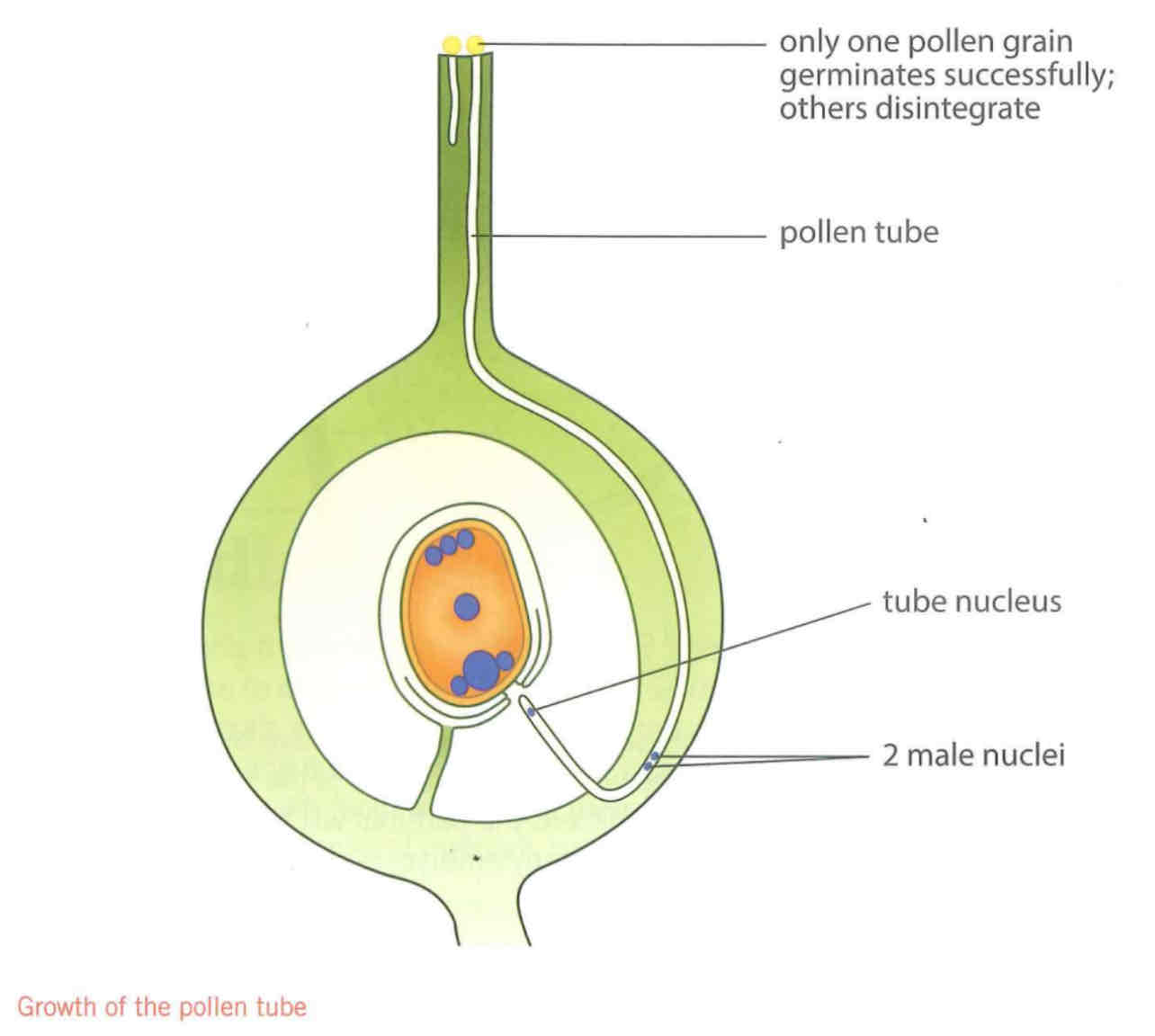
What is the nucellus?
A layer of cells that provides nutrients to the developing embryo sac.
What surrounds the nucellus?
Two layers of protective tissue called integuments, which leave a small gap called the micropyle.
What is pollination?
It is the transfer of pollen grains from the anther to the mature stigma of a plant of the same species.
What is self pollination?
Pollen is transferred within the same flower or another flower on the same plant.
What is cross pollination?
Pollen is transferred from one flower to another flower on a different plant of the same species.
Inbreeding vs. Outbreeding:
Inbreeding:
• Leads to self-fertilization, resulting in limited genetic variation.
• Advantage: Preserves successful genomes in stable environments.
• Disadvantage: Increased chance of harmful recessive alleles.
Outbreeding:
• Leads to cross-fertilization, combining gametes from two individuals.
• Advantage: Greater genetic variation, reducing harmful allele combinations and increasing evolutionary adaptability.
Methods to Ensure Cross-Pollination:
1. Dicogamy: The stamen and stigma ripen at different times to ensure cross-pollination.
• Protandry: In species like daisies, the stamens ripen first, preventing self-pollination.
• Protogyny: In species like bluebells (less common), the stigma ripens first, ensuring that pollen from another flower is needed for pollination.
2. Genetic Incompatibility: In some plants like red clover, pollen from the same flower cannot germinate on the stigma of that flower, ensuring cross-pollination.
3. Separate Male and Female Flowers on the Same Plant: In plants like maize, the male and female reproductive organs are on separate flowers, encouraging cross-pollination.
4. Separate Male and Female Plants: In dioecious species like holly, male and female flowers are on different plants, ensuring that pollen must be transferred between plants for fertilization to occur.
What is pollination?
Pollination is the transfer of pollen grains from the anther of one flower to the mature stigma of another flower of the same species. This process is essential for fertilization.
Fertilization Process:
1. Male Gamete: The male gamete is the nucleus contained in the pollen grain. It is delivered to the female gamete through the pollen tube.
2. Female Gamete: The female gamete is located in the ovule, protected within the ovary.
What is double fertilization?
Double fertilization occurs in flowering plants and involves two fusions:
• One fusion forms the zygote.
• The other fusion forms the endosperm.
How does double fertilization occur?
1. Pollen Grain Germination: When a compatible pollen grain lands on the stigma, it absorbs the sucrose solution secreted by the stigma and germinates. The pollen tube grows out of the pollen grain through a gap in the cell wall called a pit and extends down the style.
2. Pollen Tube Growth: The pollen tube grows along a chemical gradient of chemoattractants (e.g., GABA from the ovule) and enters the style. The tube is guided by the pollen tube nucleus at the tip, which directs the production of enzymes like cellulases and proteases. These enzymes break down the tissues in the style to aid the pollen tube’s growth.
3. Entry into the Ovule: The pollen tube enters the ovule through a gap in the integuments called the micropyle and delivers two male gametes into the embryo sac. The pollen tube nucleus disintegrates, having completed its role.
4. Fertilization:
• One male gamete (haploid) fuses with the female gamete (the oosphere, also haploid) to form a zygote (diploid).
• The second male gamete (haploid) fuses with the diploid pollen nucleus to form a triploid nucleus.
5. Endosperm Formation: The triploid nucleus develops into the endosperm, a tissue that provides nutrition for the developing embryo. The endosperm divides by mitosis to form a storage tissue for the embryo.
Why Is Double Fertilization Called “Double”?
Double fertilization is called “double” because two separate fusions occur:
1. One fusion forms the diploid zygote.
2. The other fusion forms the triploid endosperm
What Happens After Fertilization?
After fertilization, the fruit and seed develop. The seed develops from the fertilized ovule and contains an embryonic plant and a food store.
How Does the Fruit and Seed Develop?
• The diploid zygote divides by mitosis, becoming an embryo, which consists of the plumule (the developing shoot), the radicle (the developing root), and one or two cotyledons (seed leaves).
• The triploid endosperm nucleus develops into a food store that provides nourishment for the developing embryo.
• The outer integument dries out or hardens and becomes waterproof, with deposits of lignin. This becomes the seed coat or testa.
• The micropyle remains as a pore in the seed.
• The ovule, now comprising the embryo, endosperm, and testa, becomes the seed.
• The funicle, or stalk of the ovule, becomes the funicle of the seed, attaching to the seed at the hilum.
• The ovary becomes the fruit. In some species, such as cherries, the ovary wall becomes sweet, juicy, and pigmented. In others, such as almonds, the ovary wall becomes dry and hard.
What Is the Fruit?
The fruit is a structure developed from the ovary wall that contains one or more seeds.
What Is the Seed?
The seed is a structure developed from a fertilized ovule, containing an embryo and a food store enclosed within a testa.
Structure of the Fruit and Seed:
• The ovary of a broad bean flower contains several ovules. After fertilization, the ovary elongates into a pod, which is a fruit. The ovules mature into seeds, which are broad beans.
• Why is a broad bean classified as a dicotyledon? Because its seeds have two seed leaves or cotyledons. The embryo lies between them.
What Is the Plumule?
The plumule is the part of the embryo that will become the shoot.
What Is the Radicle?
The radicle is the part of the embryo that will become the root.
What Happens to the Endosperm?
The endosperm, which was the food store for the early embryo, is absorbed into the cotyledons, so the broad bean has a non-endospermic seed.
Why Is Maize Classified as a Monocotyledon?
Maize is classified as a monocotyledon because it has only one cotyledon. Typically, in cereal grains, the endosperm remains as the food store, so maize seeds are endospermic. The cotyledon remains small and does not develop further. Like other grasses and cereals, the testa of a maize seed fuses with the ovary wall, so maize has a one-seeded fruit.
What Is Dormancy?
Dormancy describes a seed when its active growth is suspended. Germination will only occur when specific conditions are met.
Why Do Seeds Become Dormant?
Seeds become dormant when their water content falls below 10%, which reduces their metabolic rate. They can survive long periods in this state and will not germinate until conditions are suitable.
What Provides Nutrition for the Developing Embryo?
The developing embryo’s nutrition is provided by:
1. The nucleus (for some species),
2. The endosperm (in many species),
3. The cotyledons (in some plants, one or two).
What Are the Two Main Groups of Flowering Plants?
The two main groups of flowering plants are monocots and dicots. Monocotyledons are important because they include cereals.
What Is Seed Dispersal?
Seed dispersal is the movement of seeds away from the parent plant.
What Would Happen If a Seed Germinated Close to Its Parent?
If a seed germinated close to its parent, the parent plant would be more successful at obtaining water and minerals from the soil. It would be taller and cast shade over the seedling, preventing it from photosynthesizing adequately. The seedling would be outcompeted. Seeds with features that allow them to be dispersed produce plants that avoid competition.
Dispersal Methods:
1. Wind: Ash and sycamore fruits have sails that allow wind dispersal. Dandelion fruits have a parachute of stiff hairs. The fruit of the poppy has pores through which seeds are shaken out when the stem is blown by the wind.
Example: Dandelion seeds.
2. Transport: Birds eat seeds that pass through their digestive system and are dispersed in their feces (e.g., cherries). Mammals, reptiles, and fish can also disperse seeds this way in a process called scarification. The digestive system weakens the testa by physical attack, bioacid, and enzymes, and the seeds of some species can only germinate when this happens.
Example: Song thrush eating berries.
3. Rolling: When the fruit of a horse chestnut tree breaks open, the conker (seed) falls to the ground and rolls away from the parent tree.
Example: Horse chestnut fruit releasing conkers.
4. Bursting: When legume pods dry, they split and scatter the seeds (e.g., beans). In many species, the pods rotate as they burst open, sending the seeds in many different directions.
Example: Pea pods splitting open.
5. Water: Coconut palms grow by water. Coconuts are seeds that, when they fall into the water, float because their air cavities make them buoyant and are carried away.
Example: Coconut palm.
6. Carrying: Hooked seeds attach to animal coats and are carried away.
Example: Burdock.
What Are Some Evolutionary Developments of Seeds That Have Contributed to the Success of Angiosperms?
• Dormant seeds have a low metabolic rate, allowing them to survive very cold or dry conditions.
• The testa is chemically resistant, so seeds can survive adverse chemical conditions.
• The water content of a dormant seed is reduced below 10%, so seeds can endure dry conditions.
• The testa can physically protect the embryo.
• The endosperm or cotyledons provide a supply of nutrients without loss.
• The emerging seedling can photosynthesize adequately.
• Seeds can be dispersed over great distances from the parent plant, avoiding competition and allowing for the colonization of new habitats.
• Inhibitors may prevent germination until the right conditions are met, often broken down in cold weather through a process called vernalization, so seeds can germinate in the spring. In cabbages, the inhibitors are in the seeds, and in tomatoes, they are in the fruits.
What Is Germination?
Germination is a biochemical and physiological process through which a seed transforms into a photosynthesizing plant. It begins with vigorous biochemical and developmental activity and continues until the first photosynthesizing leaves are produced. By this time, all the food stored in the endosperm or cotyledons has been used up.
What Happens After Dormancy?
After dormancy, when environmental conditions become favorable, a seed will begin the process of germination.
What Are the Three Main Requirements for Successful Germination?
1. A Suitable Temperature: The optimum temperature for germination is the one that best suits the enzymes involved in the process. This temperature range varies between species but typically falls between 5°C and 30°C.
2. Water: Water is necessary to mobilize enzymes for transport in the xylem and phloem, as well as to make cells turgid by filling their vacuoles.
3. Oxygen: Oxygen is required for aerobic respiration, which releases energy to fuel metabolism and growth.
What Is the Effect of Light on Germination Between Species?
• Daisy seeds need light to germinate.
• Ivy seeds require darkness to germinate.
• Geranium seeds can germinate in either light or darkness.
What Happens When Conditions Are Suitable?
When environmental conditions are favorable, water is rapidly absorbed by the seed through the micropyle, a small pore that was present in the ovary and persists in the seed.
What Does Water Cause the Tissue to Do?
Water causes the tissues to swell and creates the optimal conditions for enzyme activity. Food reserves in the seed are typically insoluble in water and cannot be directly transported to the embryo. To be used, these reserves must first be broken down into soluble molecules.
• Amylase hydrolyzes starch into maltose.
• Proteases hydrolyze proteins into amino acids.
Where Are the Soluble Products Transported?
The soluble products are transported to the embryo, carried in the phloem to the apical meristems of the plumeal (developing shoot) and radical (developing root), where rapid cell division occurs.
What Happens When the Swollen Tissues Rupture the Testa?
When the swollen tissues rupture the testa (seed coat), the radical (root) emerges. The radical is positively geotrophic (grows downward) and negatively phototrophic (grows away from light). Afterward, the plumeal (shoot) emerges. The plumeal is positively phototrophic (grows toward light) and negatively geotrophic (grows away from gravity), so it grows upwards.
Germination of Broad Bean:
In broad beans, the cotyledons (seed leaves) remain below ground during germination. The part of the plumeal above the joint between the embryo and the cotyledons elongates rapidly, pushing the plumeal upward. The plumeal forms a hook shape as it pushes through the soil, which helps protect the tip from soil abrasion.
If the seed has been planted at the correct depth, once the plumeal emerges, the hook straightens, and the leaves unfurl, beginning to photosynthesize. By this time, the food reserves in the cotyledons have been depleted.
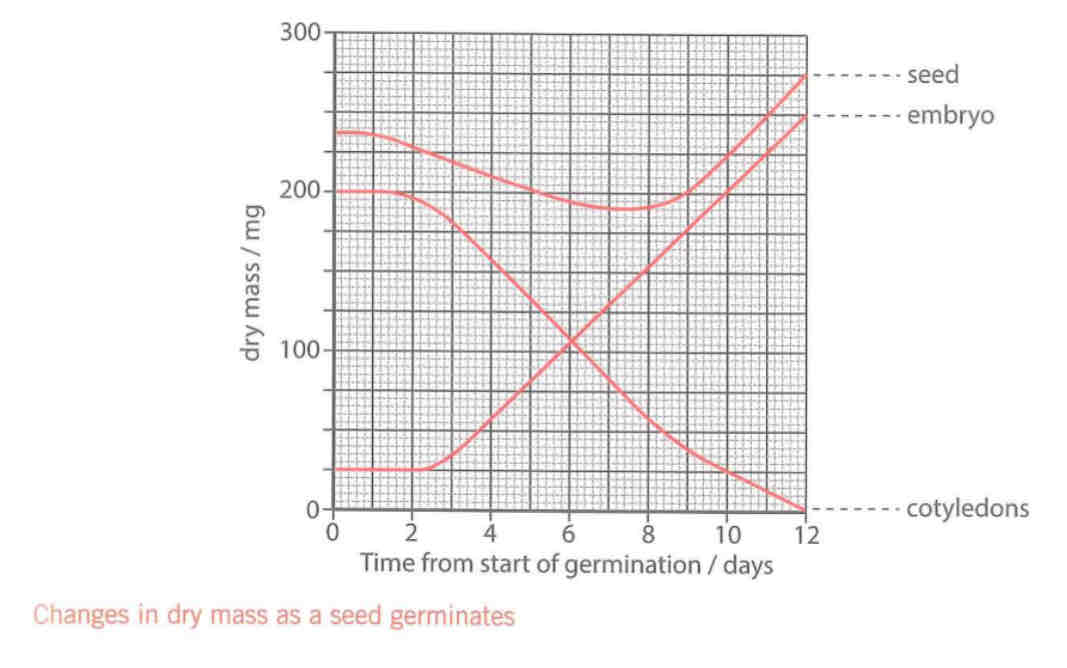
Can you explain this graph?
1. The Embryo (Developing into the Seedling): This refers to the part of the seed that eventually grows into the plant.
2. The Cutting Leaf (Cotyledons or Seed Leaves): These are the initial leaves of the seed that often provide nutrition to the embryo during the early stages of germination.
Phases of Germination and Growth:
1. Initial Phase (Pre-Germination):
• Dry Mass of the Embryo: At the start of germination, the dry mass of the embryo (or the seedling) is relatively low because it hasn’t yet begun to grow and develop into a full plant. The embryo is in a dormant state until the seed absorbs water and starts to swell.
2. Water Uptake and Seed Activation:
• As soon as favorable conditions (such as warmth, moisture, and oxygen) are present, water is absorbed through the micropyle, triggering the germination process. The embryo becomes metabolically active, and enzymes begin to break down stored food in the seed (such as starch, lipids, and proteins) into simpler molecules (like sugars and amino acids). This process is vital for providing the energy and building blocks necessary for cell growth and division.
• Dry Mass of the Cutting Leaf (Cotyledons): The cotyledons, or seed leaves, act as food stores that provide nutrients to the growing embryo. Initially, these cotyledons are full of energy-rich reserves that sustain the embryo until the young seedling can start photosynthesizing. During this stage, the cotyledons gradually lose dry mass because they are metabolizing their stored nutrients to support the developing seedling.
3. Active Growth and Development (Around Day 5 to 10):
• Dry Mass of the Embryo (Seedling): As the embryo starts to grow into a seedling, it undergoes rapid cell division and elongation. The seedling begins developing roots (the radical) and shoots (the plumeal) that will eventually form the plant’s root system and above-ground structures. The growing tissues of the seedling require nutrients and energy, and this is where the breakdown of the food reserves in the cotyledons becomes important. The dry mass of the embryo increases as the seedling continues to grow and develop, with cells expanding and using energy for photosynthesis and respiration.
• Dry Mass of the Cotyledons: As the cotyledons are utilized to provide energy and nutrients, their dry mass continues to decrease. Initially, cotyledons are rich in food reserves such as starch, proteins, and lipids. However, as the seedling uses these reserves for growth, their dry mass diminishes. At some point, the cotyledons may wither or fall off entirely, as their role is to act as the initial food supply until the seedling can produce its own food through photosynthesis.
4. Post-Germination Phase (Beyond 10 Days):
• Dry Mass of the Seedling: As the seedling matures and its roots anchor into the soil, the leaves begin to unfurl and photosynthesize. Once the leaves are fully exposed to light, they start producing glucose and other organic compounds through photosynthesis. These nutrients are transported to the growing parts of the plant for continued growth, leading to a dramatic increase in dry mass of the seedling.
• Dry Mass of Cotyledons: By this point, the cotyledons have either been fully used up or may have shriveled and fallen off. The cotyledons have fulfilled their purpose of providing the initial nourishment for the seedling’s early development. From this point onward, the seedling will rely on photosynthesis and soil nutrients (like water and minerals) to fuel its growth.
Extra Explanation:
The increase in dry mass of the embryo and the decrease in dry mass of the cotyledons during seed germination is a clear representation of how plants shift from reliance on stored energy in the seed to independent growth through photosynthesis.
• Seed Reserves: The food stored in the seed (such as starch and proteins) is crucial for the early stages of growth when the seedling is not yet capable of producing its own food. These reserves are broken down and transported to the embryo for growth.
• Photosynthesis: Once the seedling’s leaves are exposed to light, it begins photosynthesizing, which marks a transition from being dependent on seed reserves to being self-sufficient in producing energy for growth. The dry mass increase of the seedling at this stage is primarily due to the creation of new biomass from the sugars produced in photosynthesis.
Key Takeaways:
• Dry Mass Increase of Embryo: The embryo (now developing into a seedling) grows and gains dry mass as it produces new tissues, such as roots and shoots, and starts photosynthesizing.
• Dry Mass Decrease of Cotyledons: The cotyledons lose dry mass because they are providing food for the developing seedling. Once their reserves are depleted, they either wither or fall off.
How does brewing industry use germinating barley seeds?
The brewing industry uses germinating barley seeds in a process known as malting, which is crucial for beer production. During malting, barley grains are allowed to germinate under controlled conditions to convert their stored starches into simpler sugars, mainly maltose, that can be fermented by yeast to produce alcohol.
Why are gibberellins used in the brewing industry?
• Accelerating Germination: Gibberellins are applied to barley seeds in the malting process to speed up germination. This allows for a shorter malting period, reducing the time required to produce malted barley.
• Increased Efficiency: By using gibberellins, the brewing industry can increase efficiency by producing more malt in a shorter amount of time, which is especially beneficial for large-scale beer production.
• Control over Enzyme Production: Gibberellin treatment helps control the production of the necessary enzymes (such as amylase and protease), which are critical for breaking down starches and proteins in the barley. This ensures the process occurs uniformly and optimally.
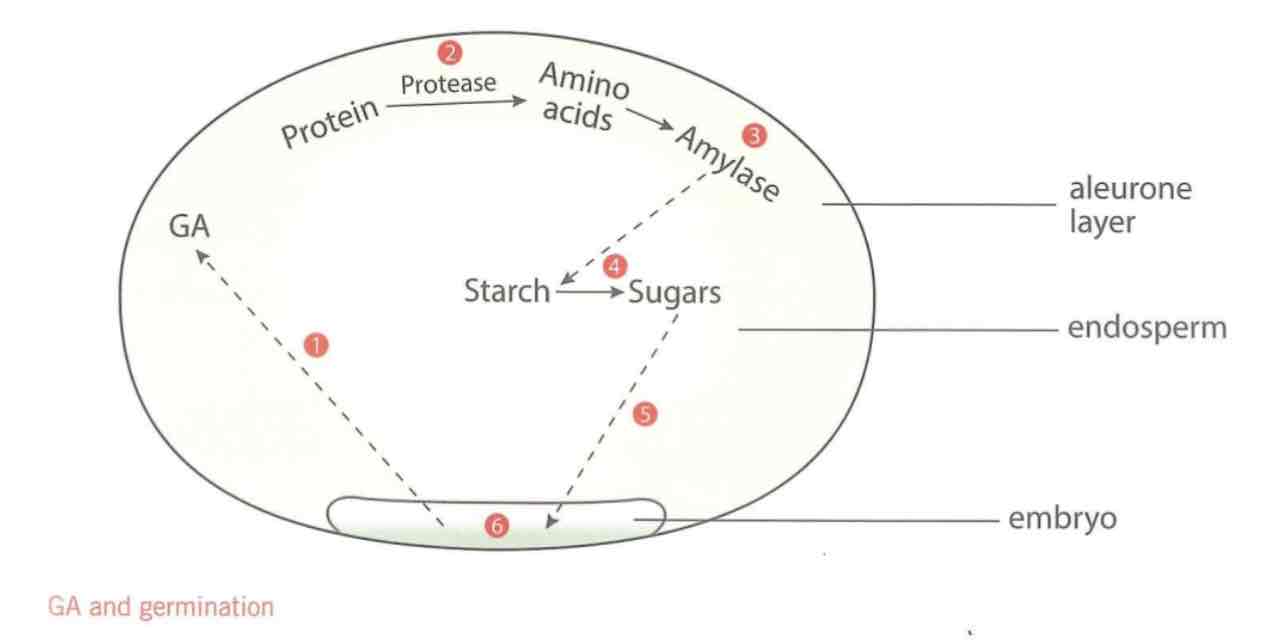
Explain the GA and germination process?
The barley embryo secretes a plant growth regulator, gibberellic acid, which diffuses through the endosperm to the aleurone layer. This is a layer of cells towards the outside of the seed, which has a high protein content.
The gibberellic acid switches on genes in the cells of the aleurone layer, resulting in transcription and translation, producing enzymes including protease and amylase.
The proteases hydrolyse protein in the aleurone layer to amino acids, which are used to make amylase.
The amylase diffuses out of the aleurone layer and hydrolyses the starch stored in the endosperm cells.
The maltose and glucose produced diffuse back through the endosperm to the plumule and radicle of the embryo.
They are respired for energy, which fuels biosynthesis and cell division and which brings the seed out of dormancy.
Explain the differences between insect pollinated and wind pollinated flowers?

Explain the differences between monocots and dicots?

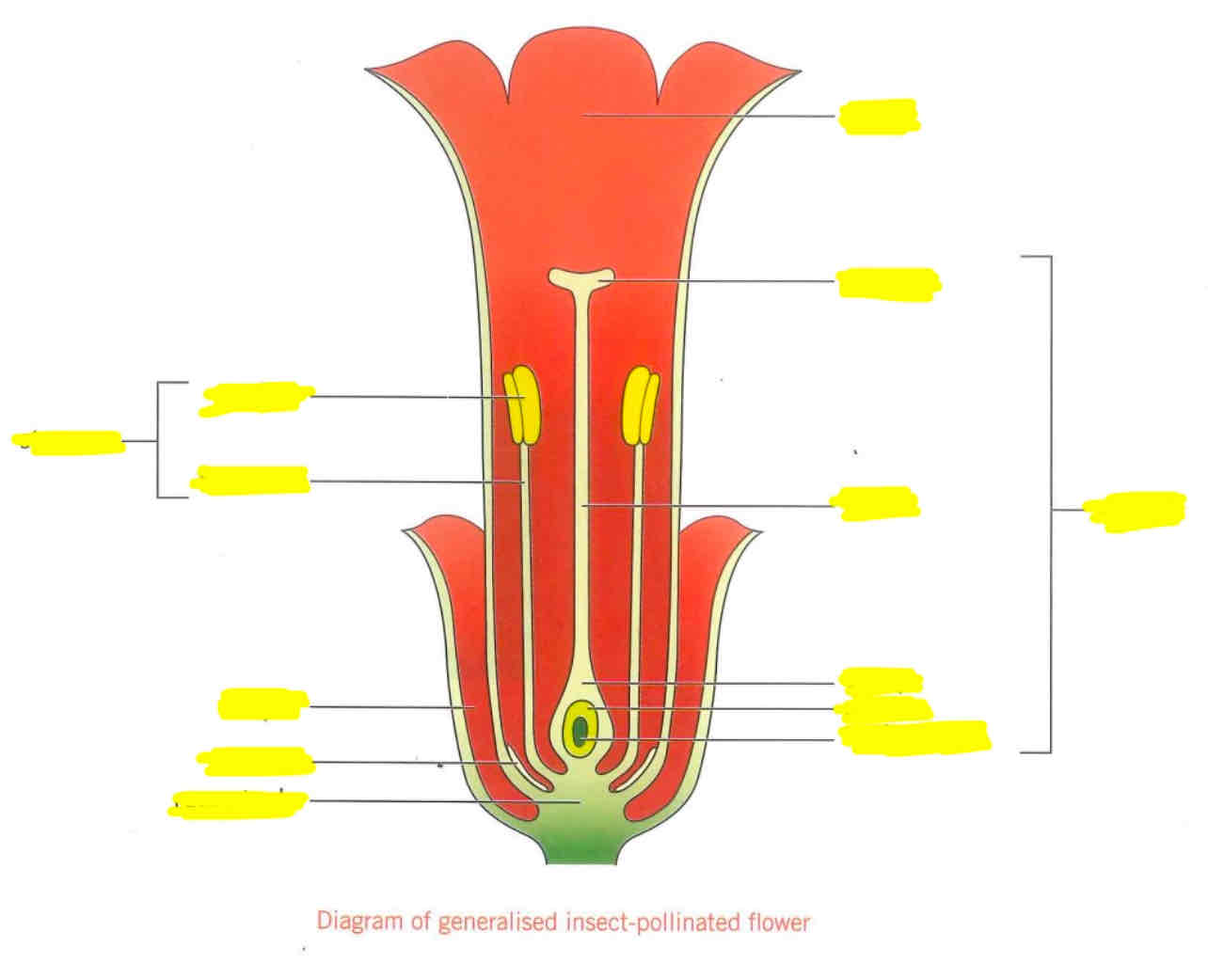
Label the parts of generalized insect pollinated flower?
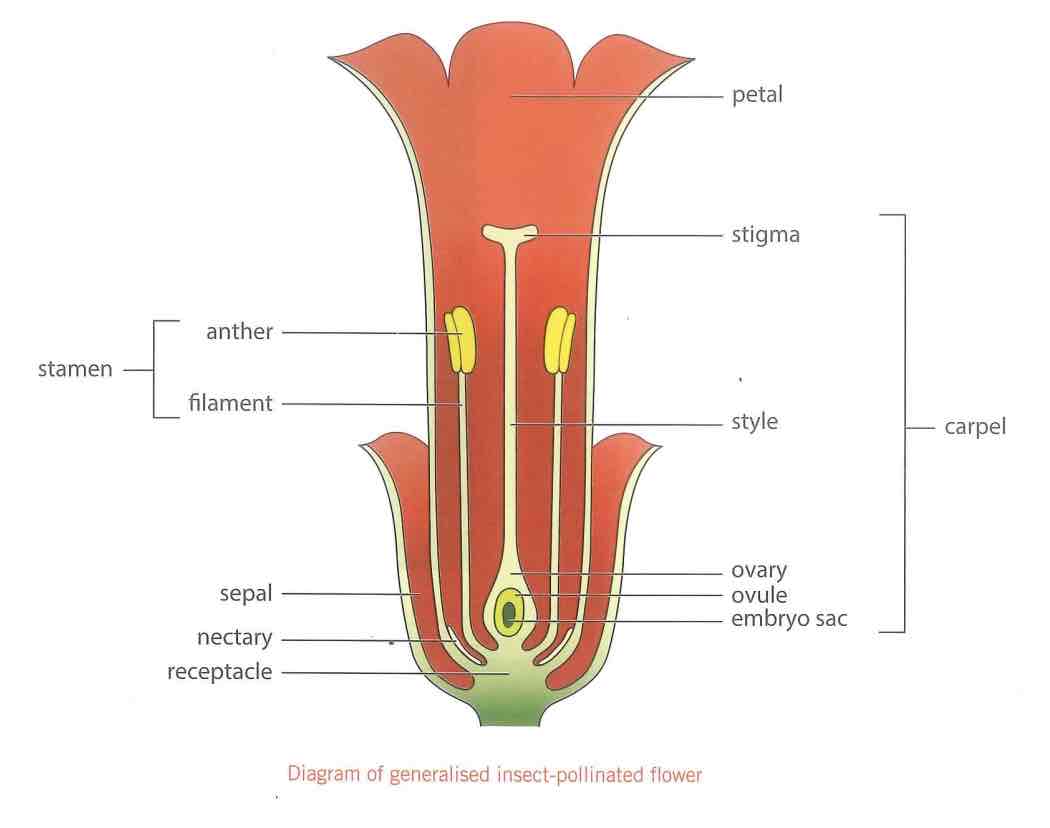
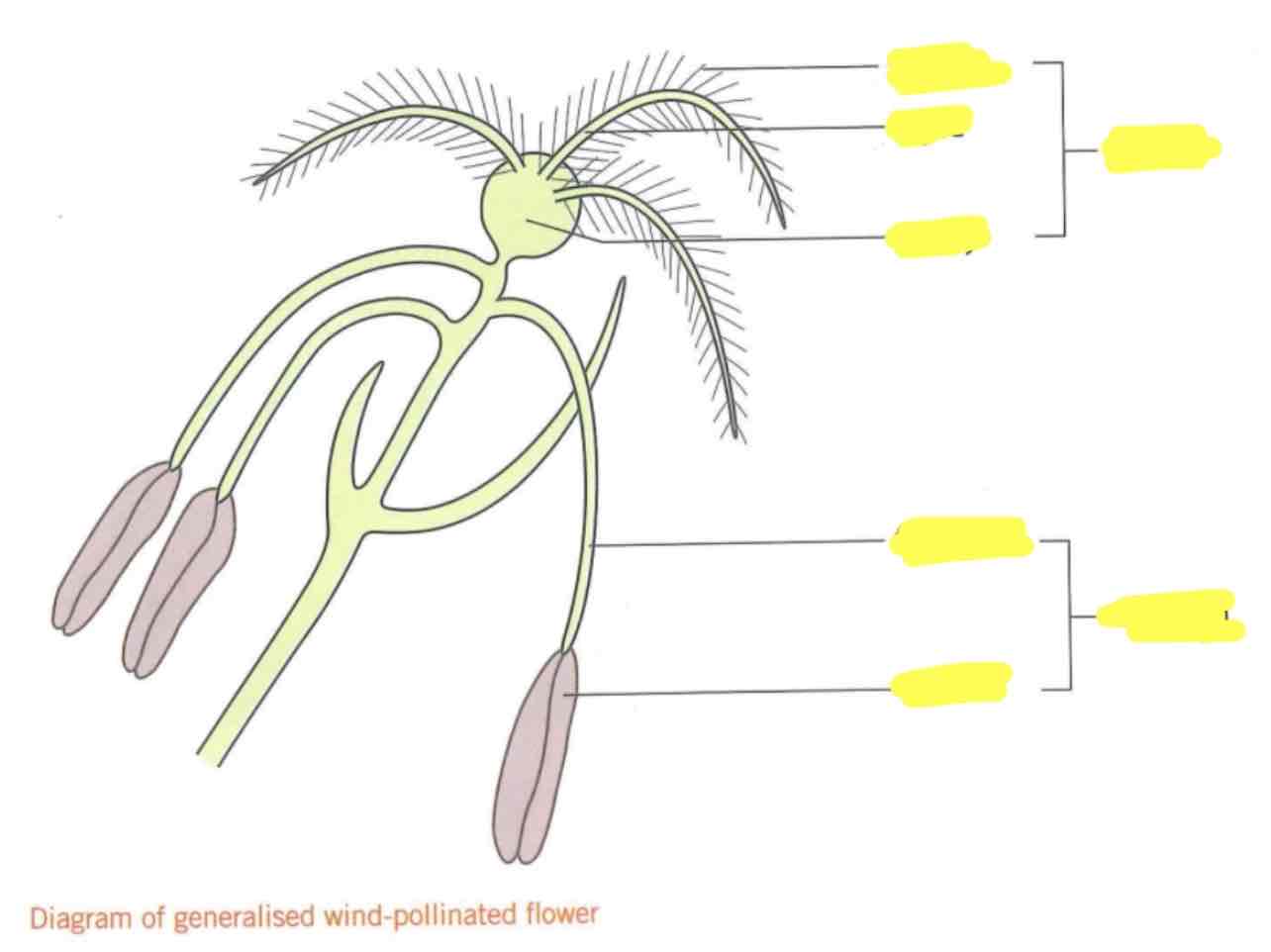
Label the diagram of an generalized wind pollinated flower?

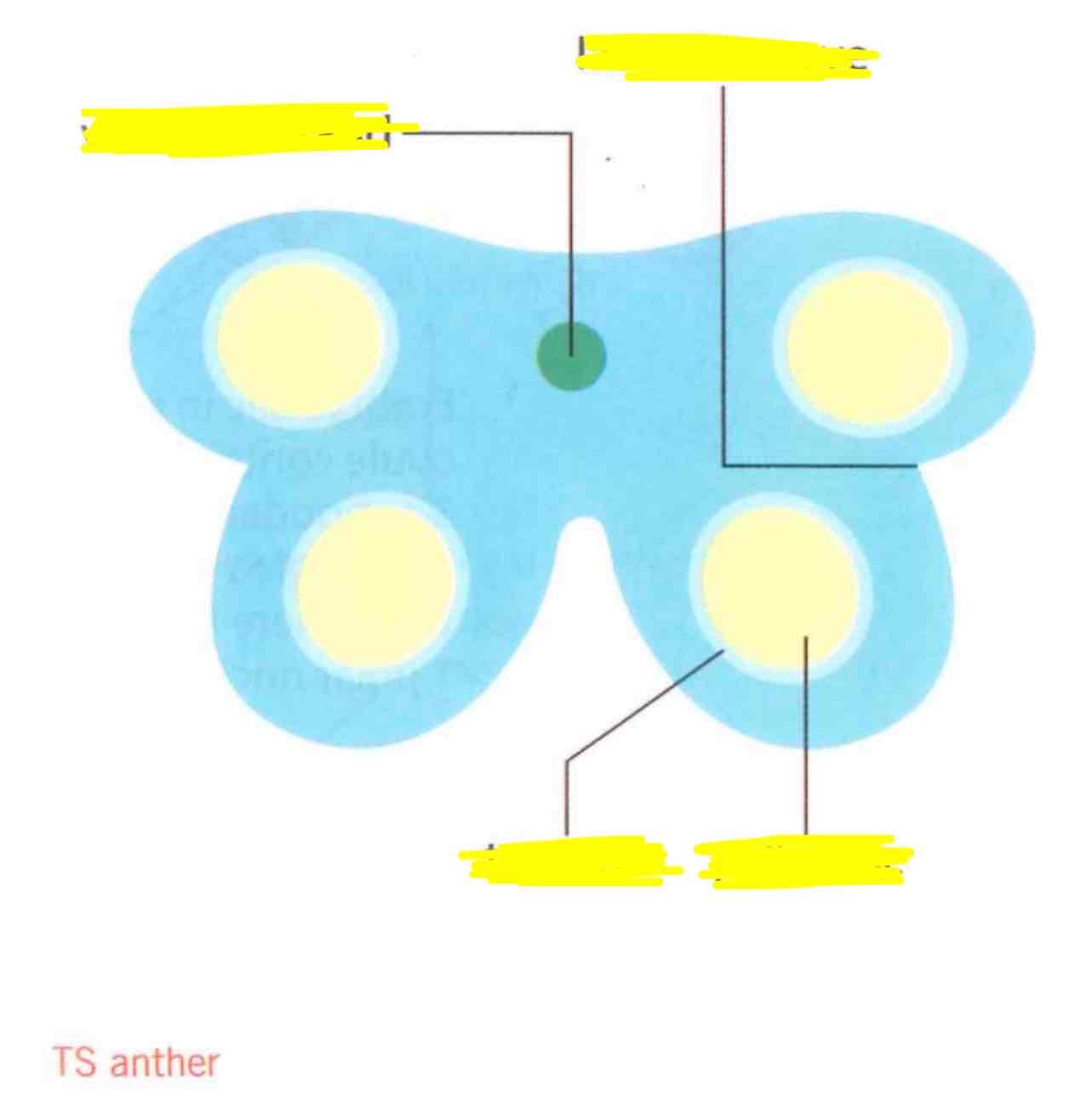
Label the parts of a TS anther?
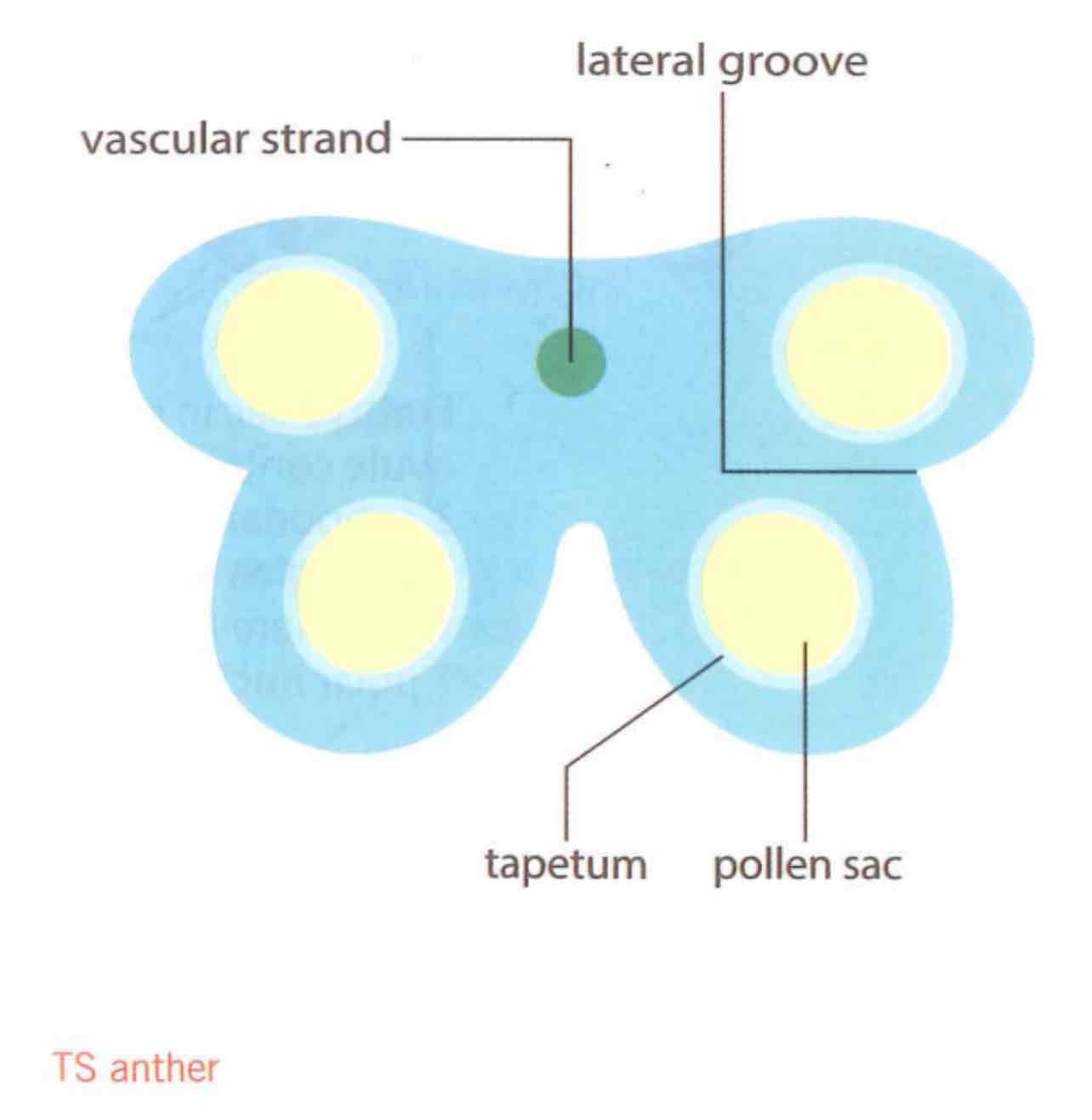
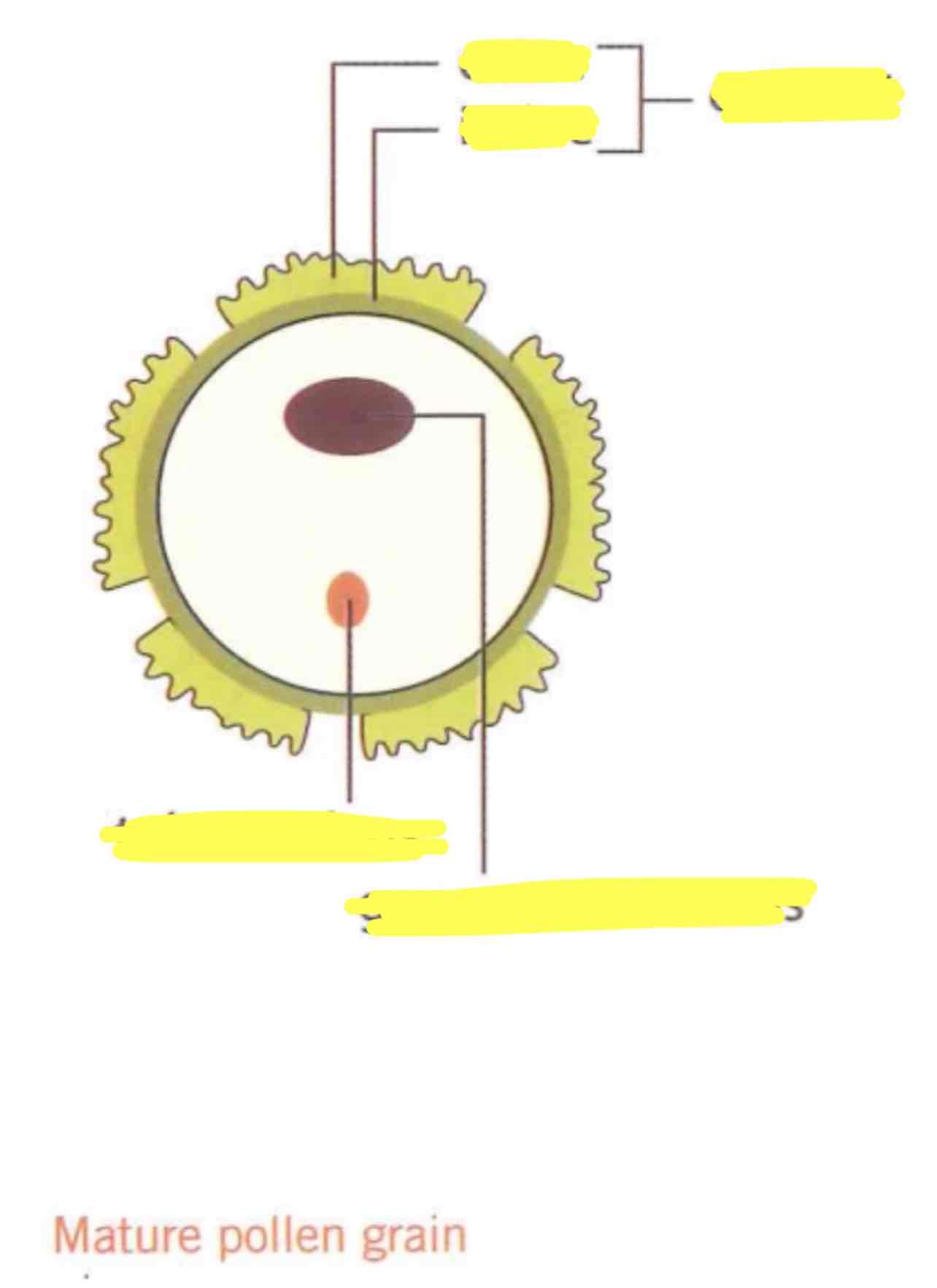
Label the parts of a mature pollen grain?

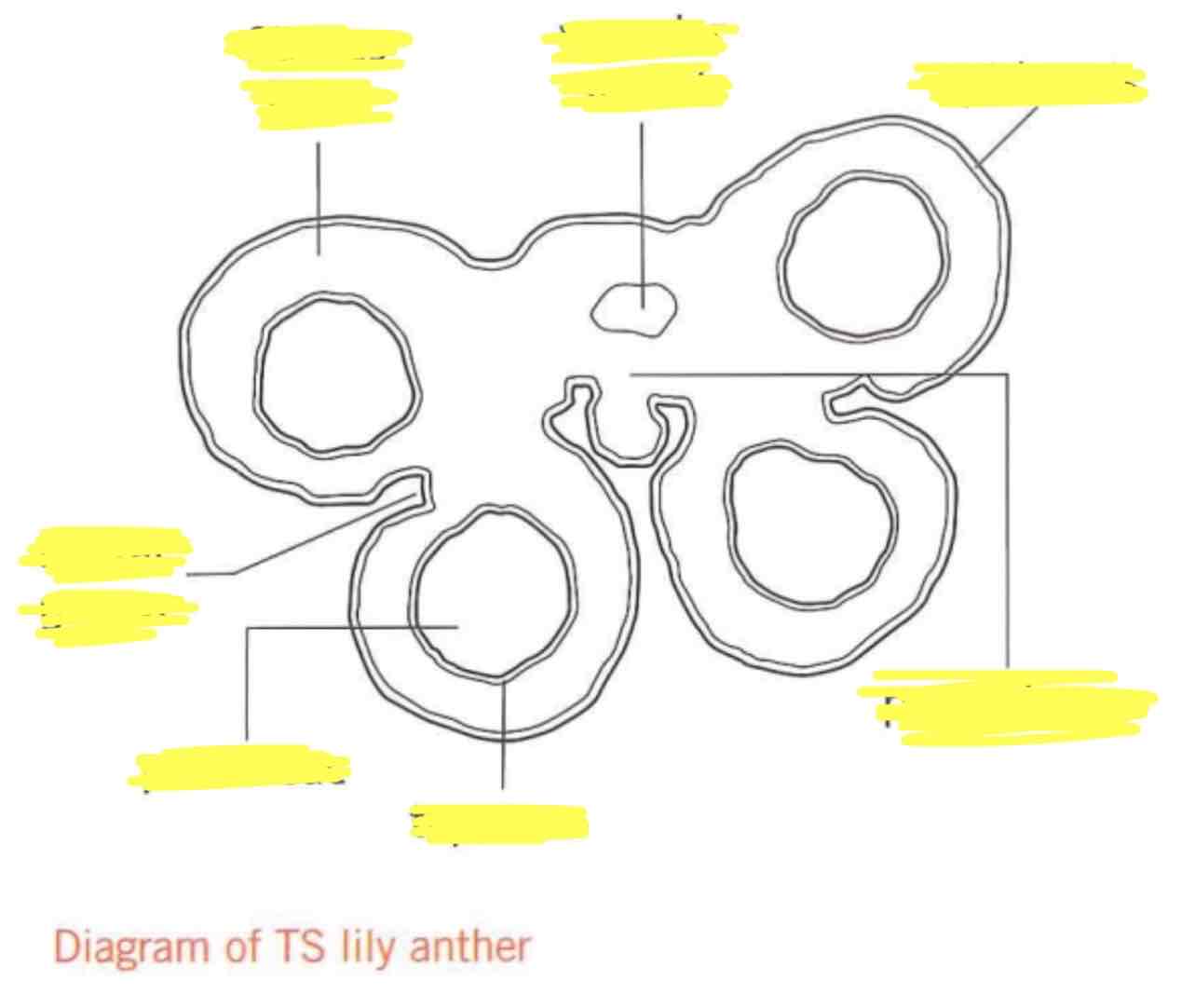
Label the diagram of TS lily anther?

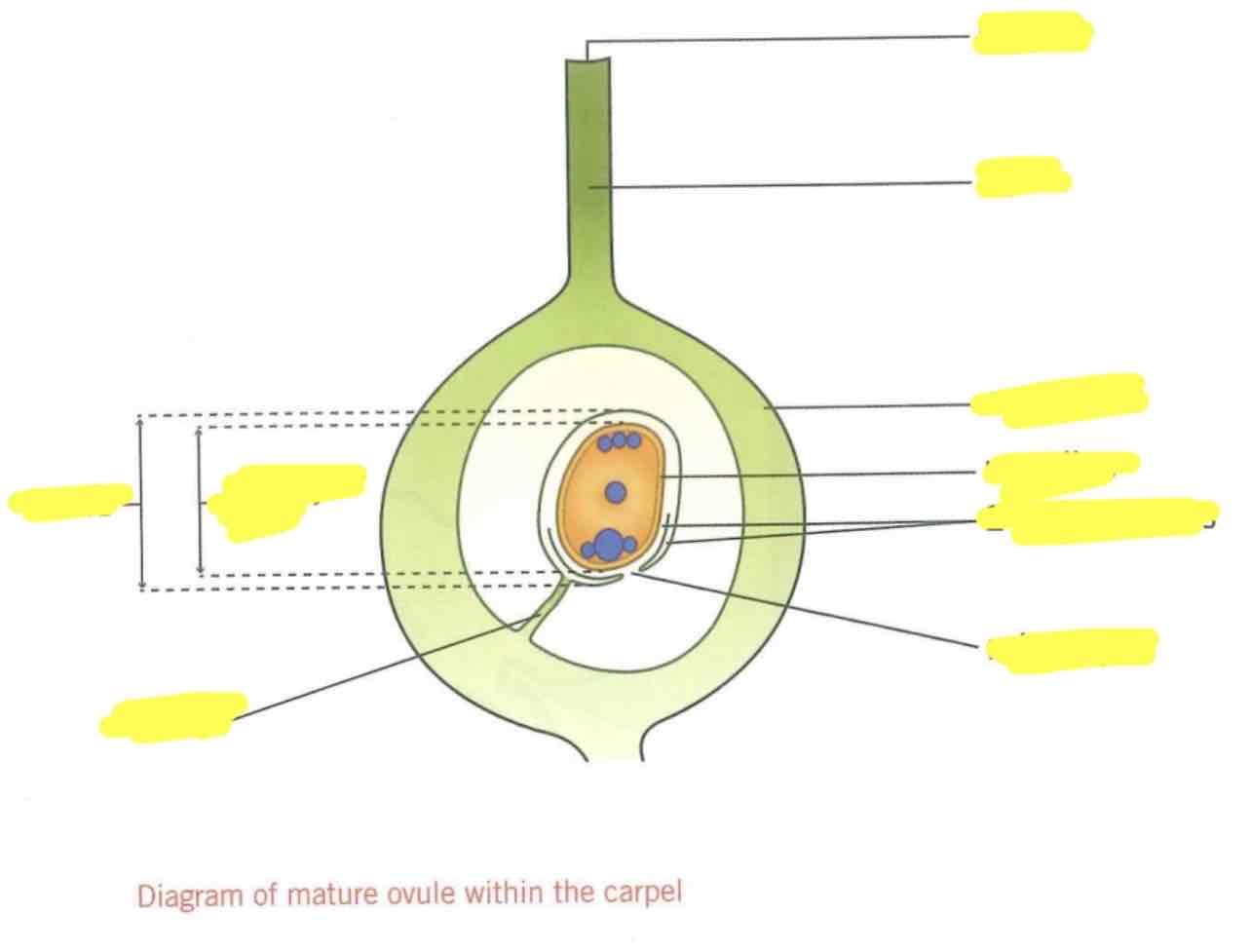
Label the diagram of mature ovule within the carpel?
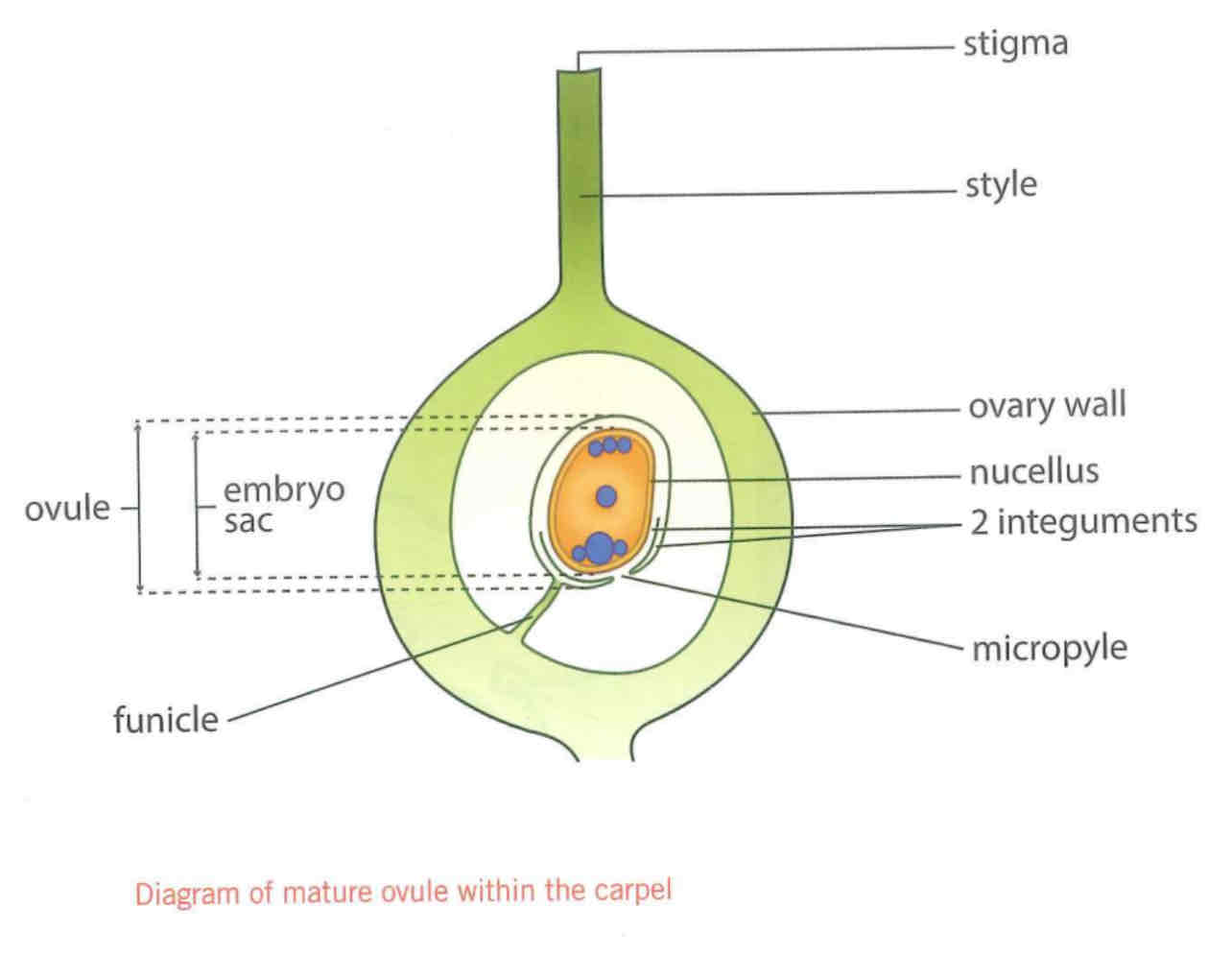
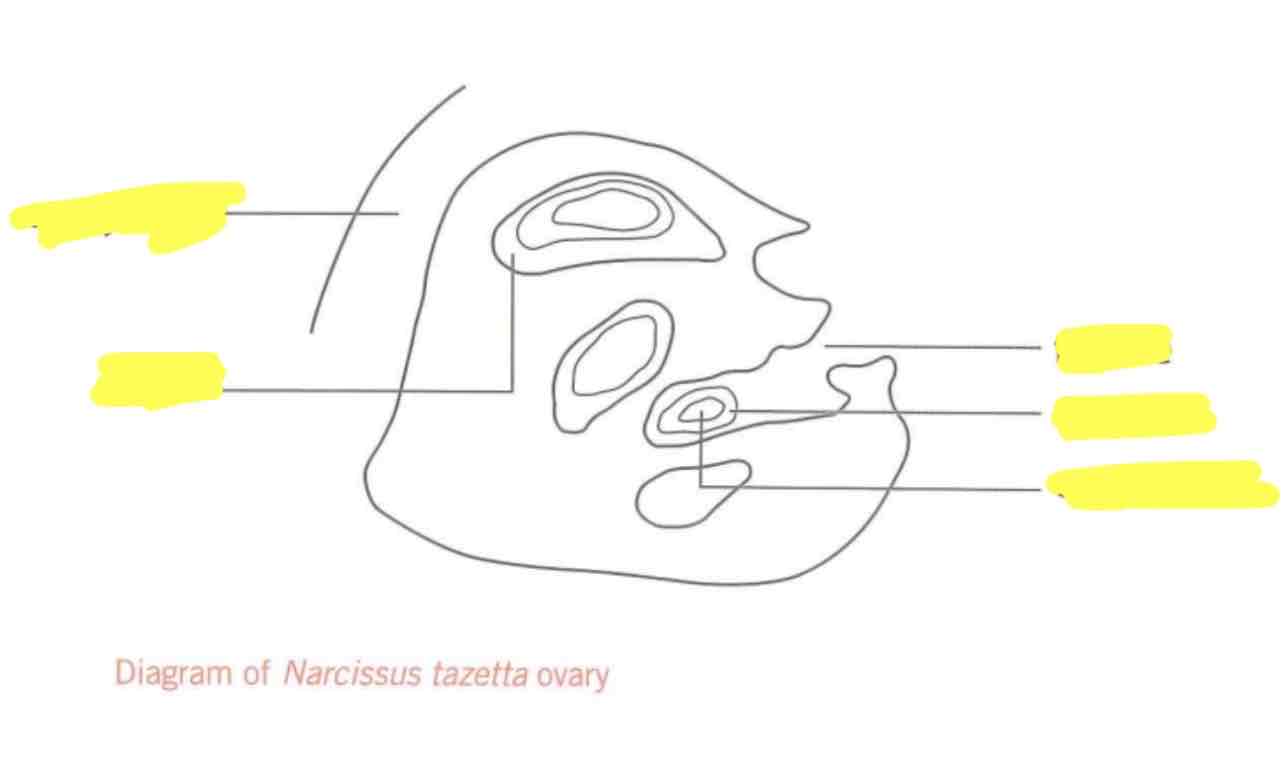
Label the diagram of Narcissus tazzeta ovary.
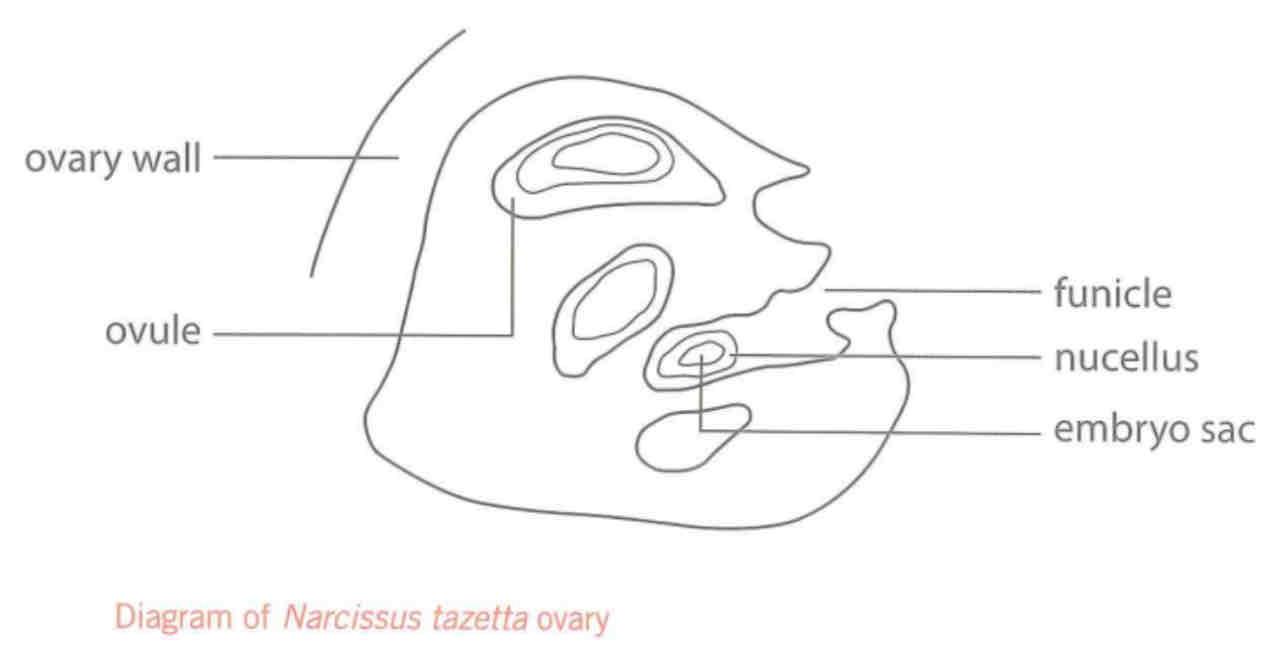
The flow diagram summarises the formation of the nuclei in the mature pollen grain and in the embryo sac:
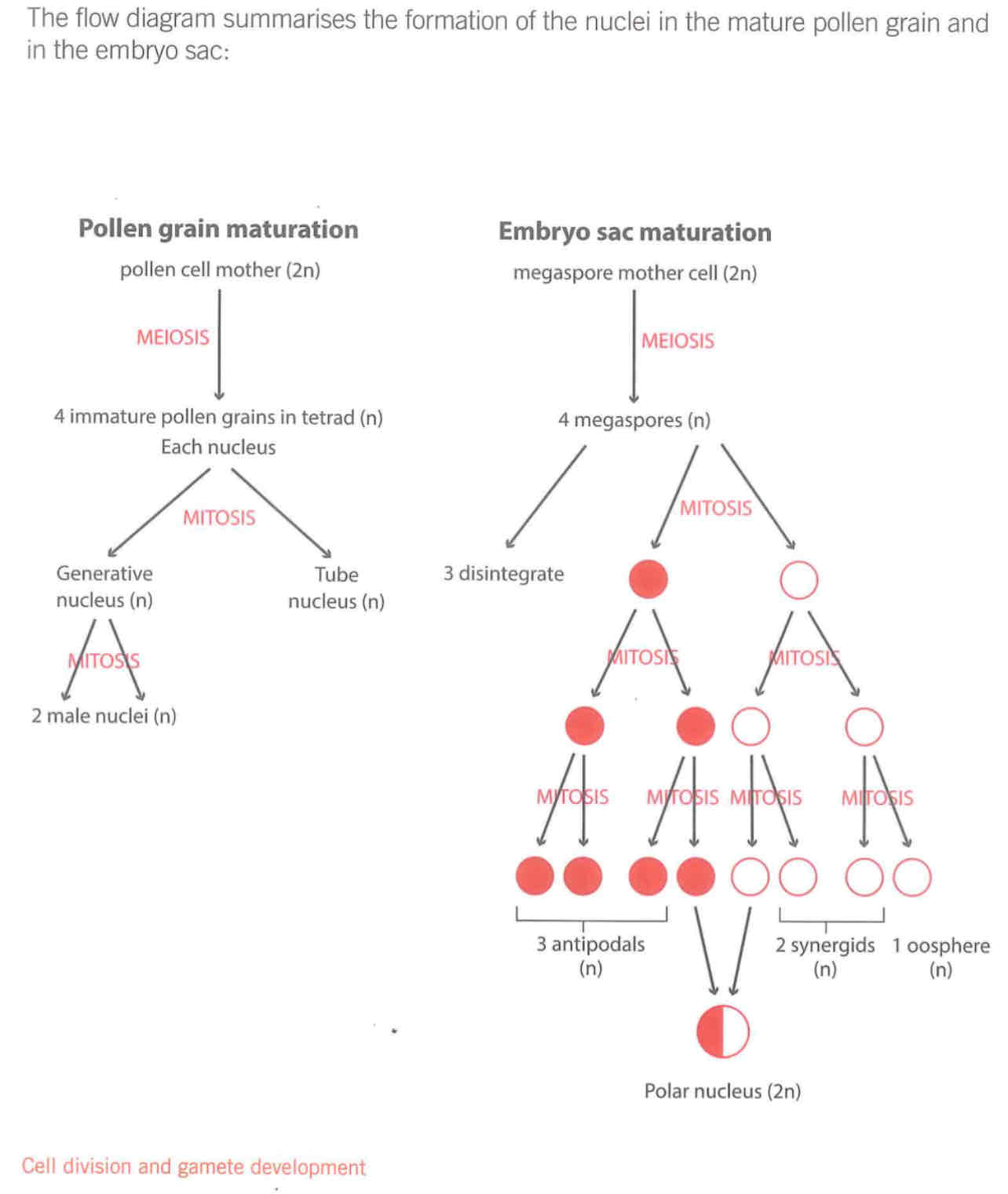
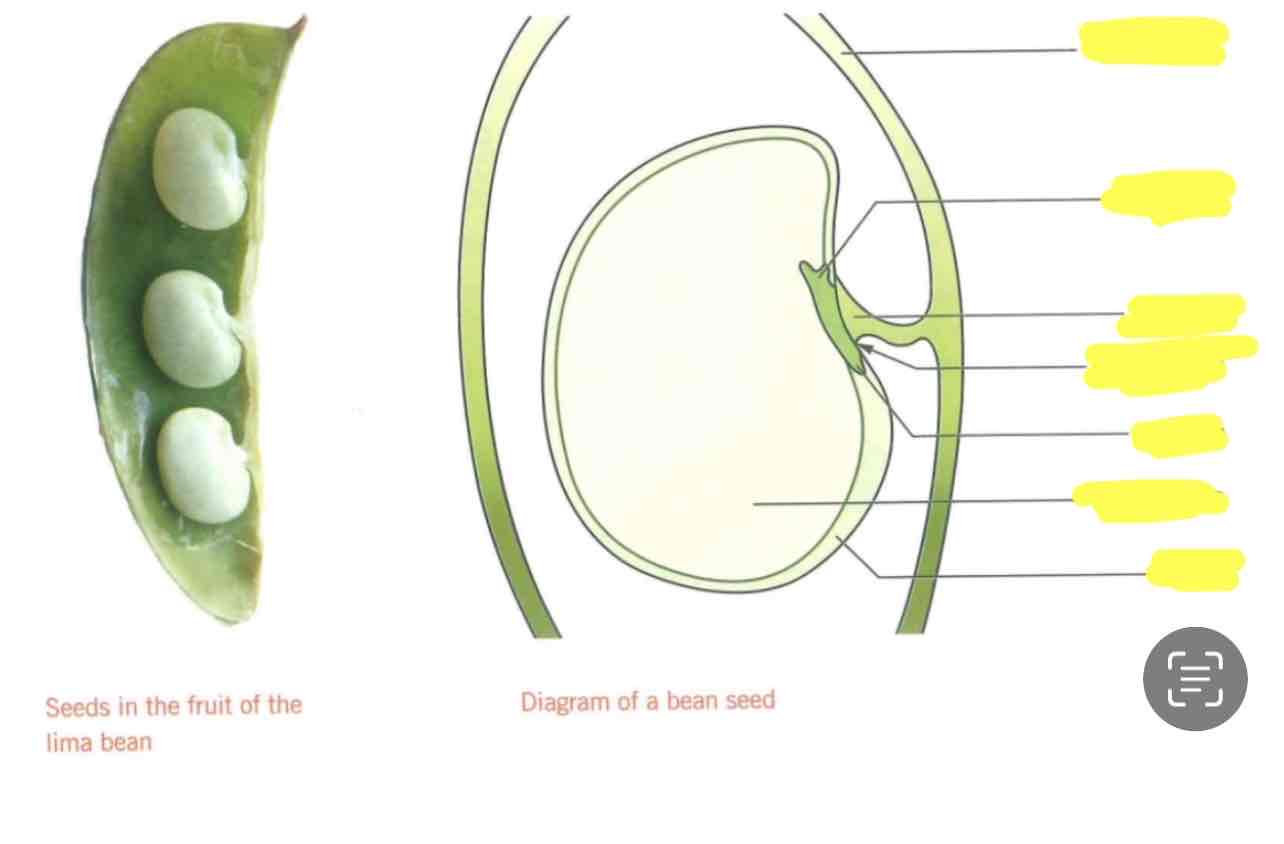
Label the diagram of a bean seed:
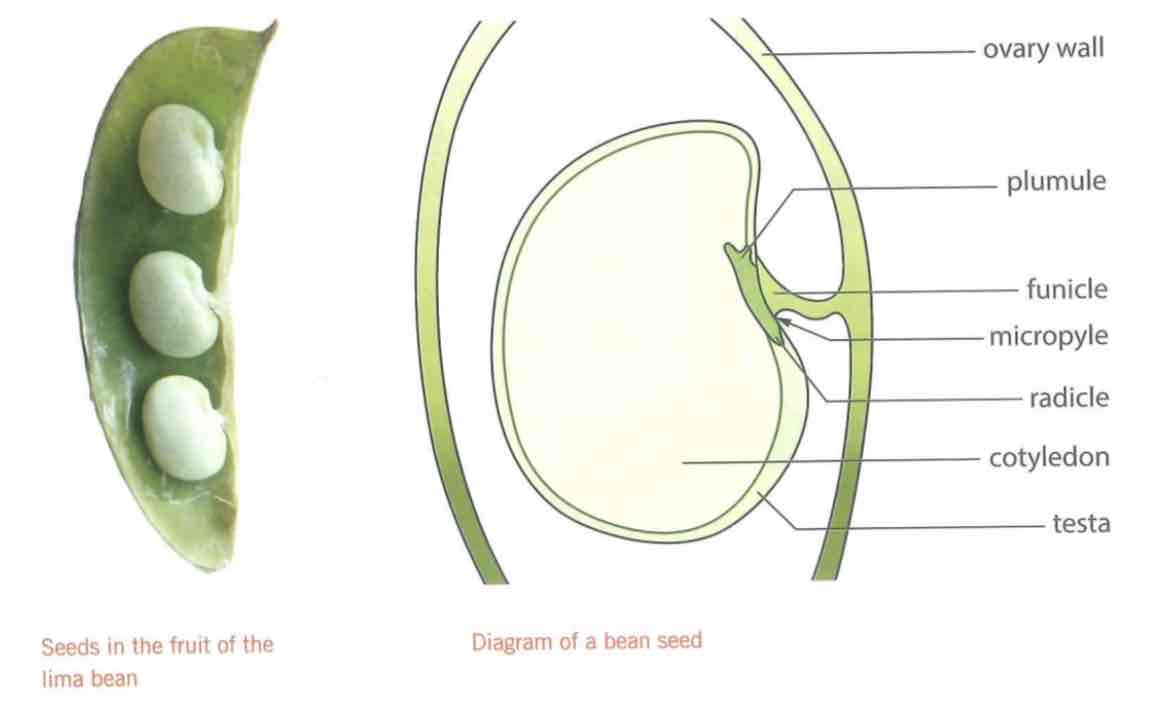
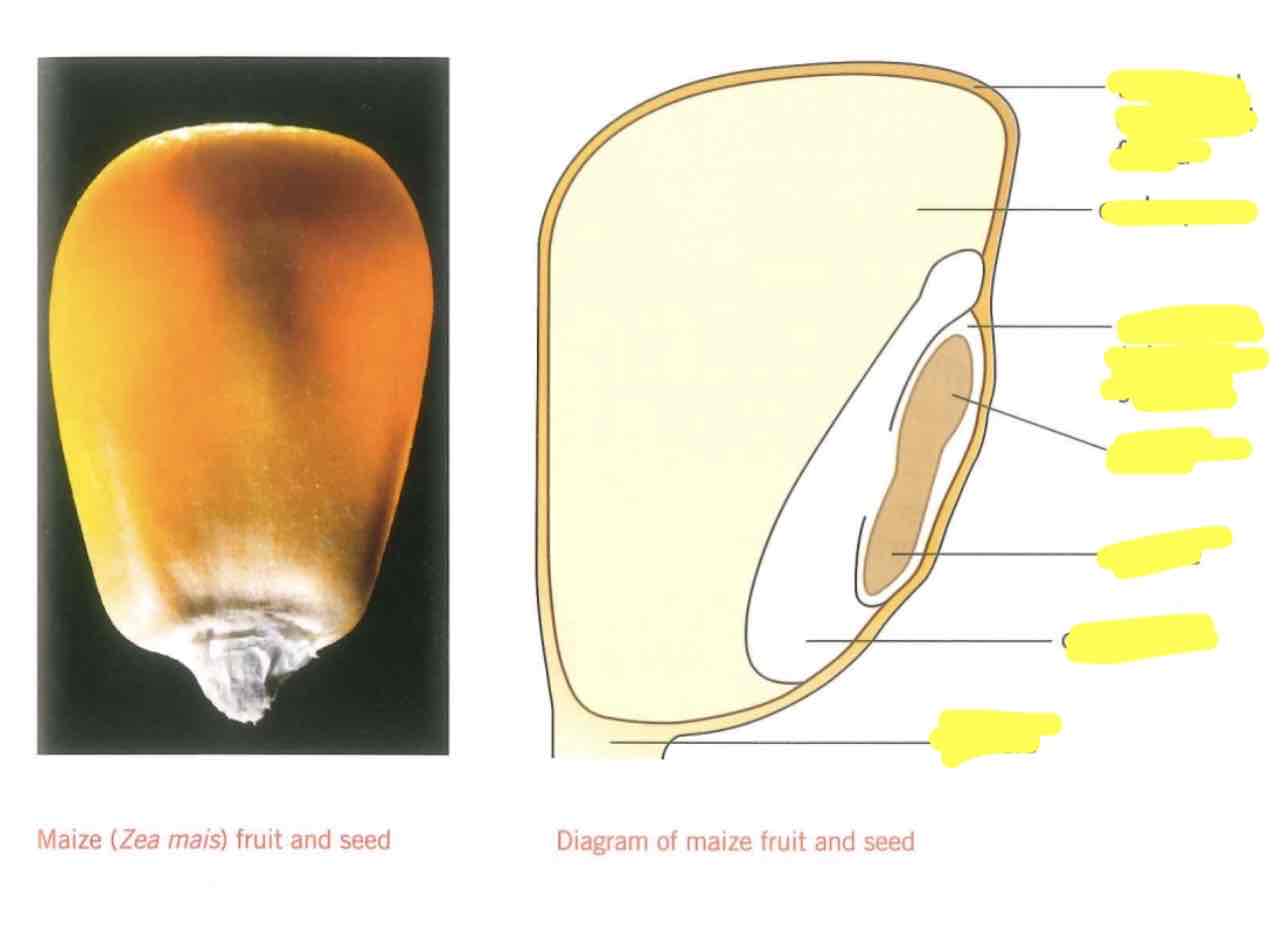
Label the diagram of a maize fruit and seed:
